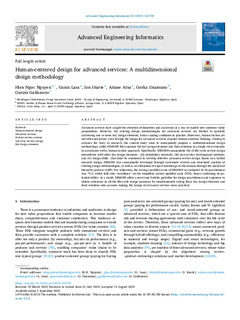| dc.rights.license | Attribution-NonCommercial-NoDerivatives 4.0 International | * |
| dc.contributor.author | Nguyen Ngoc, Hien | |
| dc.contributor.author | Lasa, Ganix | |
| dc.contributor.author | Iriarte, Ion | |
| dc.contributor.author | Atxa Gamboa, Ariane | |
| dc.contributor.other | Unamuno, Gorka | |
| dc.contributor.other | Galfarsoro Urrestilla, Gurutz | |
| dc.date.accessioned | 2022-11-09T15:07:28Z | |
| dc.date.available | 2022-11-09T15:07:28Z | |
| dc.date.issued | 2022 | |
| dc.identifier.issn | 1474-0346 | en |
| dc.identifier.other | https://katalogoa.mondragon.edu/janium-bin/janium_login_opac.pl?find&ficha_no=168384 | en |
| dc.identifier.uri | https://hdl.handle.net/20.500.11984/5817 | |
| dc.description.abstract | Advanced services have caught the attention of industries and academics as a way to exploit new customer value propositions. However, the existing design methodologies for advanced services are limited to partially addressing one or some key design elements, hence causing confusion in practice. Moreover, human factors are not often addressed, even though the design for advanced services requires human-centered thinking. Aiming to advance the body of research, the current study aims to conceptually propose a multidimensional design methodology called DIMAND that captures the key design elements and their relations in a single-view structure in accordance with a human-centric approach. Specifically, DIMAND encapsulates the (i) life-cycle service design interrelated with other key design elements—(ii) stakeholder networks, (iii) new service development methods, and (iv) design skills—that must be considered to develop effective advanced service design. Based on a hybrid research design, DIMAND was conceptually developed through systematic reviews and structured analysis of existing design methodologies, as well as an elicitation of expert knowledge in the domain through the analytical hierarchy process (AHP). For validation, the average usability score of DIMAND as evaluated by 26 practitioners was 72.2, which falls into “excellence” on the simplified system usability scale (SUS), hence confirming its potential utility. As a result, DIMAND offers a novel and holistic guideline for design practitioners and engineers to obtain coherence in all the life-cycle design processes by simultaneously taking these key design elements and their relations into account, making the design of advanced services more practical. | en |
| dc.description.sponsorship | Comisión Europea | es |
| dc.language.iso | eng | en |
| dc.publisher | Elsevier | en |
| dc.rights | © 2022 The Authors | en |
| dc.rights.uri | http://creativecommons.org/licenses/by-nc-nd/4.0/ | * |
| dc.subject | human-centred design | en |
| dc.subject | Advanced services | en |
| dc.subject | Product-service systems | en |
| dc.subject | Life-cycle service design | en |
| dc.subject | Key design elements | en |
| dc.title | Human-centered design for advanced services: A multidimensional design methodology | en |
| dcterms.accessRights | http://purl.org/coar/access_right/c_abf2 | en |
| dcterms.source | Advanced Engineering Informatics | en |
| local.contributor.group | Centro de Innovación en Diseño | es |
| local.contributor.group | Innovación, gestión, organización | es |
| local.description.peerreviewed | true | en |
| local.identifier.doi | https://doi.org/10.1016/j.aei.2022.101720 | en |
| local.relation.projectID | info:eu-repo/grantAgreement/EC/H2020/814078/EU/Digital Manufacturing and Design Training Network/DiManD | en |
| local.contributor.otherinstitution | https://ror.org/003qafx79 | es |
| local.contributor.otherinstitution | Urola | es |
| local.source.details | Vol. 53. Article 101720. August, 2022 | en |
| oaire.format.mimetype | application/pdf | |
| oaire.file | $DSPACE\assetstore | |
| oaire.resourceType | http://purl.org/coar/resource_type/c_6501 | en |
| oaire.version | http://purl.org/coar/version/c_970fb48d4fbd8a85 | en |








